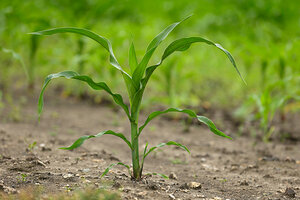Year after drought, wettest Midwest spring in 40 years delays crop planting
Last year, Midwest farmers struggled with drought; this year, it's heavy rain and sodden farmlands, which have pushed back the planting season. By contrast, farmers in the South worry about too little rain.

A corn plant sits in a field in Madrid, Iowa, last week. A wet spring has pushed back the planting of corn and soybeans this year.
Charlie Neibergall/AP
After scorching temperatures and drought conditions devastated the nation’s crop production last year, farmers across the Midwestern farm belt are now dealing with the reverse side of Mother Nature – too much rain.
Meteorologists say the region experienced the wettest spring in 40 years, with rainfall in portions of the Midwest 8 inches above normal. From January to June, Illinois – the second largest corn and soy producer – had its wettest six months in history, with 28.7 inches, which is 8.9 inches above average
Soggy farmland has pushed back the planting season, and some farmers have given up planting entirely. Farmers worry that wet soil will prevent corn and soybeans from developing the deep roots, about two to four inches, needed to fully grow. Oversaturated soil prevents roots from getting oxygen, and ideal moisture is located directly below the seed, not in the topsoil.
Much of the nation’s corn crop is sowed by July, however according to the US Department of Agriculture in its June acreage report, released last week, 91 percent of corn has yet to germinate, compared with 100 percent during the extreme drought the same time a year ago. Planted corn acres are estimated at 97.3 million, resulting in a projected harvest of 89.1 million acres, which is only slightly behind March estimates.
The agency reports that in Iowa, the leading corn producer, farmers planted about 200,000 fewer acres than expected due to the heavy rains. Other states that have seen a decrease in planted acreage are Minnesota (300,000 acres), Wisconsin (150,000 acres), and Kansas (100,00 acres).
“It’s been kind of devastating, and it's ruined quite a bit of stuff already,” Jerry Smith, who farms 700 acres of corn, soybeans, and other crops in Somers, Wis., told the Milwaukee Journal-Sentinel Friday. “We'll probably have a week or so where we won't have any sweet corn, because we weren't able to get in and plant it.”
Some states, including Texas, Nebraska, and Michigan, overcompensated for the projected shortfall by planting more acres than typical; Texas led this trend by planning 300,000 acres more than usual.
Soybean harvest is also behind this season.
The National Weather Service says the drenching rain pattern was created by a low-pressure system in the South that pumped warm moisture toward a cold front draped across the North. That resulted in persistent thunderstorms and rain showers throughout the late spring.
Despite the rainfall in the upper part of the US, farmers in the South and Southwest continue to worry about possible drought. The US Drought Monitor reported Thursday that 60 percent of the South, which includes Texas and Oklahoma, is experiencing some form of drought. Drought is also reaching into Colorado, Utah, and California; in fact, the Monitor reports that more than 76 percent of the West, with the exception of Montana, is suffering from moderate-to-exceptional drought conditions.
The hot and dry conditions expanded in the “moderate to exceptional” categories to 44.1 percent, from 43.8 percent last week. However conditions are faring better than last fall, when two-thirds of the US was in drought, the worst such condition since the 1930s.

